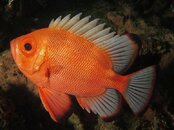Ah, range extensions. The thing about range extensions is that every Tom, Dick, and Harry report these all the time. Fishermen, scuba divers, schoolteachers, graduate students, etc. are constantly barraging taxonomists with sightings and photographs. Assuming a report makes its way to the (appropriate) taxonomist, there are a great many verification steps required for the range extension to be validated. Physical specimens for positive ID are the standard for most invertebrates (and many fishes). Precise collection information (location, time, collector) must come with those specimens. Often, the taxonomist needs to physically collect or observe specimens firsthand in their native environment.
One small secret about reported marine life distributions is that they are very, very detailed within immediate proximity of operating marine laboratories. The people who can verify the specimens either work there or have colleagues that work there. The Gulf of Mexico has few marine laboratories and qualified marine scientists, compared to the Atlantic or Pacific coasts. The work backlog of specimens may take years to get through... if ever.
All that said, I can say for a fact that much species distribution for critters in the Gulf of Mexico is in much better shape than is normally accessible from the internet or field guides. The grey literature from federal and state monitoring studies (as well as graduate theses and dissertations) often contains species lists containing all sorts of wacky critters and potential range extensions. One just has to track down all that stuff and sift through it. Great fun.
There is little/zero interest in today's universities to support (or even hire) "natural history" biologists. That ship sailed in the early 1980's. Similarly, natural history museum curatorial staffing is severely depleted. Historically, these are the people that have been responsible for filtering and publishing natural history information to the general public. With most of these specialists gone, the monitoring agency biologists (NMFS, NPS, etc.) are the only game in town. These folks (may) operate as regional "parataxonomists", but their job duties are very specific to fulfilling agency directives. Thus, if you want to find out what they know, you have to either contact them directly, or sift through their monitoring reports.
The northern Gulf of Mexico transitions between two maritime biogeographic provinces between winter and summer. It is one enormous ecotone with massive species flux. Rapid climate change and exotic species make their mark on regional habitat structure as well. One might argue that areas like this are "ripe" for study, as one is always seeing weird/new stuff. The argument can also be made that expensive university monitoring programs are pointless and a waste of money to operate in such areas, due to the inherent ecological dynamicism of the region. Politicians have tended to prefer the latter argument...
I am not a fish person, but I would recommend that Dan Pauly's FishBase would be a good place to seek out (or supply) fish-related life history info. I am not sure if the website is still in full operation, I am currently getting some downed service links.





